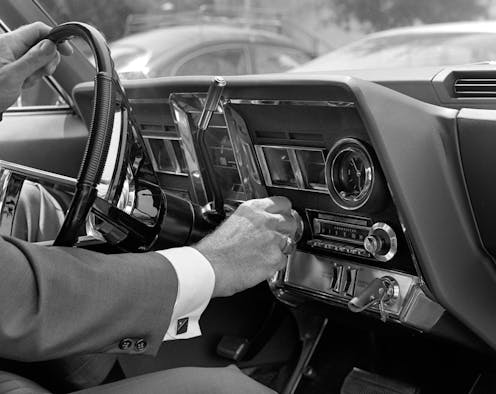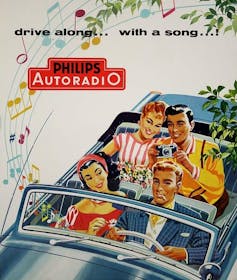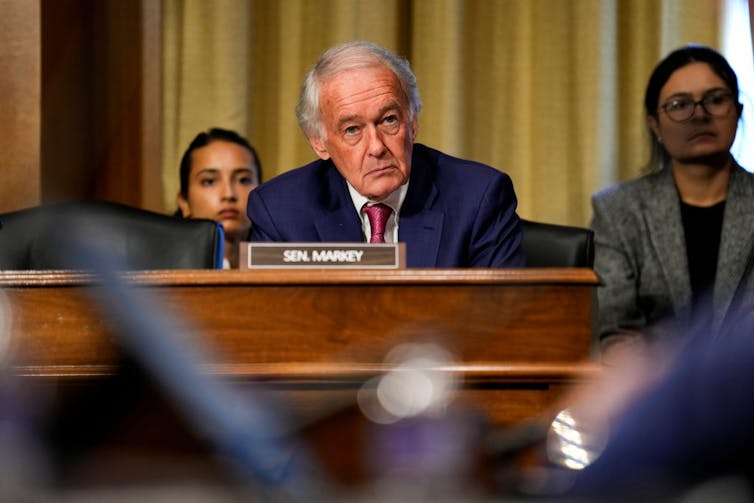Congress is trying to force carmakers to keep AM radio − it should also use this opportunity to corr
Corporate-controlled, political infotainment makes up the bulk of AM radio programming. But there was a time when these stations were more attuned to the needs of the community.

A lament about the demise of AM radio has been rising in the halls of Congress.
Several automakers, most notably Tesla and Ford, have decided to stop putting AM radios in their electric vehicles. They claim their electric motors interfere with the audio quality of the signal and insist that FM and satellite radio are enough.
Given that people who listen to radio tend to primarily do so while driving, a trend like this could threaten the commercial viability of the over 4,000 AM stations currently broadcasting in the U.S.
The radio industry has been fighting back, lobbying for legislation that would force carmakers to install AM radios as a matter of public interest. These efforts led to the AM Radio for Every Vehicle Act being deliberated in both houses of Congress.
U.S. Sen. Ed Markey, a Massachusetts Democrat who sponsored the bill in the Senate, described free AM radio as “an essential tool in emergencies, a crucial part of our diverse media ecosystem, and an irreplaceable source for news, weather, sports, and entertainment for tens of millions of listeners.”
As a media historian, I welcome hearing AM radio described as a public utility, particularly after decades of free-market orthodoxy dominating discussions of its fate.
The story of a new medium
When AM – short for “amplitude modulation” – arrived at the turn of the 20th century, it was championed as a revolutionary technology that could bring a nation together in time and space. Over the next decade, engineers developed new technologies such as uniwave arc transmitters to send the signal and vacuum tubes to help amplify it upon reception, so that first voices and then music could be heard over AM broadcasts.
While early radio amateurs harnessed its potential to connect and inform, the era of unlicensed amateur broadcasting ended during World War I due to fears that the new medium might be misused to spread foreign propaganda or divisive content.
After KDKA went on the air in Pittsburgh as the first licensed commercial station in November 1920, AM radio stations popped up across the nation, serving local audiences a wide variety of formats. Houses were now filled with the sounds of news, baseball games, radio dramas or crooners singing popular music. Radios flew off the shelves to meet the demand.
Because listening stokes the imagination in unique ways, broadcasters – and the advertisers that paid to access audiences – found new ways of using radio to capture listeners’ attention.
By the 1930s, AM radio was a dominant form of mass media in America, served by networks of stations – NBC, CBS and Mutual – with both local and syndicated programming. While commercial interests saw radio as a means to generate profit, a growing chorus of advocates viewed radio as a public utility that should be made to serve the public interest.
That public conversation inspired the Communications Act of 1934 and the creation of the Federal Communications Commission, which was charged with ensuring that licensed stations abide by certain standards.
These standards flowed from an ongoing debate at the FCC about the public interest obligations of radio broadcasters. In the late 1930s, the agency started requiring licensed stations to remain neutral in matters of news and politics. The “no-editorializing spirit” of the Mayflower decision compelled the FCC in 1949 to establish its fairness doctrine later that year.
The emerging regulatory oversight helped check America’s first radio demagogue, Father Coughlin, whose conspiratorial tirades were heard by some 30 million listeners. Over the course of several years, Coughlin’s refusal to comply with regulatory guidelines – combined with fear of sponsor backlash – caused him to be dropped by radio networks.
Radio comes along for the ride
The sounds of AM radio started accompanying drivers in their cars in the late 1920s.
The vehicles of that era featured closed cabins that protected drivers and passengers from weather and noise. People who listened to music on their home radios embraced the idea of listening while driving. Companies such as the Automobile Radio Corporation promoted expensive Transitone radios that ran on a 6-volt battery with the tagline, “You’re never alone with a Transitone.”
In 1930, General Motors began installing radios in its new Cadillacs. Chrysler advertised luxury cars factory-wired for owners to install Transitones. Now, drivers traveling on America’s vast and growing national highway systems could do so while listening to the radio.
As the decade progressed, factory-installed radios – mounted on the floor, with controls on the dash and speakers above the windshield – were touted as a way to enhance the driving experience. As a Philco radio commercial from 1934 put it, “You wouldn’t be without a radio at home – why be without one in your car?”
By 1940, at a time when 61% of Americans listened regularly to news on the radio, 20% of cars in the U.S. had built-in radios.
Corporations capture the airwaves
In the 1950s, transistor technology made it possible for smaller radios to be installed in the dashboard of over half of the cars on the market.
But now, drivers had a different technology they could tune into: FM radio.

Short for “frequency modulation,” this spectrum – though it required more power – was less prone to static and offered better sound quality. The early days of FM were characterized by innovation and vibrant local programming. But that gradually ceded to commercial pressures as big media companies consolidated their power. Slowly but surely, music programming shifted away from AM to FM.
By the mid-1980s, the once robust conversation about radio serving the public interest was muted by lobbyists and politicians who pushed for deregulation that would boost profits. One by one, rules requiring broadcasters to devote set amounts of time to public affairs programming, rules that limited the number of stations in a media market that a company could own to seven, and news and public affairs programming guidelines such as the fairness doctrine all fell like pawns to an industry fixated on profit.
The FCC and Federal Trade Commission shrugged as big corporations bought up and consolidated radio stations, reducing local programming and replacing it with syndicated content beamed in by satellite.
The Telecommunications Act of 1996 gave it all away, effectively ceding decisions about the future of AM and FM radio to corporate interests and asking almost nothing in return.
Over the next two decades, America’s radio stations would be gobbled up by a handful of conglomerates such as Clear Channel, now known as iHeartMedia. The majority of AM stations, especially those in rural areas, where people spend a lot of time listening in their cars, prioritized right-wing talk shows.
And though radio demagogues such as Rush Limbaugh and his many imitators salvaged the profitability of AM radio, there are huge swaths of rural America where the captured spectrum serves as a delivery system for monotone partisan programming that sounds a lot like Father Coughlin in the 1930s. Instead of providing farm reports, emergency information and local news to cultivate an informed citizenry, now most corporate-owned AM stations air divisive, grievance-filled infotainment that serves the needs of ownership.
On the road, again
It doesn’t have to be that way.
The FCC once asked stations to serve the public interest in exchange for their licenses, a regulatory quid pro quo that generated a broader range of programming that better served communities.
It’s possible to take that road again. Just look at Low Power FM community radio, which emerged as a nonprofit answer to industry homogenization designed to serve the public interest.
Freed from corporate control, homegrown Low Power FM community radio boosts local democracy by offering a microphone to local musicians and a diverse range of commentators, voices often denied access to commercial radio. Stations can apply for Low Power FM community radio licenses; though the reception range is very limited, the number of stations serving communities ranging from Iuka, Mississippi, to the Umatilla Indian Reservation in Oregon, has doubled in the past decade to over 1,500.

AM radio could be used similarly.
If Congress and the FCC are going to frame AM radio as an essential public service, I believe it should once again push for public interest standards in exchange for a license. Only then will AM radio live up to the spirit animating the AM Radio for Every Vehicle Act.
In other words, if the U.S. government is going to tell automakers to install AM radios as a matter of public interest, shouldn’t they also ask broadcasters to demonstrate they are worthy of the public’s trust?
Matthew Jordan does not work for, consult, own shares in or receive funding from any company or organization that would benefit from this article, and has disclosed no relevant affiliations beyond their academic appointment.
Read These Next
From truce in the trenches to cocktails at the consulate: How Christmas diplomacy seeks to exploit s
World leaders like to talk up peace at Christmastime. But alongside the tales of seasonal breaks in…
As DOJ begins to release Epstein files, his many victims deserve more attention than the powerful me
Powerful men connected to Jeffrey Epstein are named, dissected and speculated about. The survivors,…
Autocracies in transition: In 2025, Cameroon and Tanzania rulers clung to power — but look more vuln
The countries, whose respective leaders recently won widely disputed elections, offer contrasting examples…






